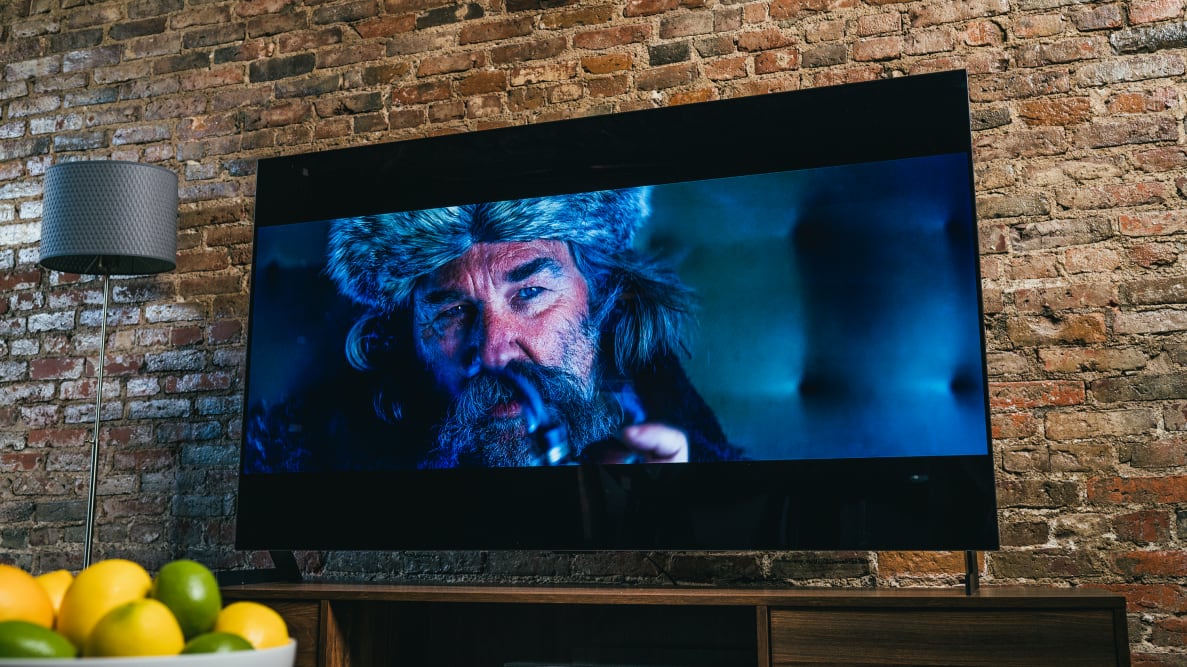Pros
-
Top-tier picture quality
-
Speedy processing
-
Beautiful design
Cons
-
Overkill for many shoppers
Updated September 16, 2022: The new 2022 Gallery Series OLED, the G2, has improvements over the G1 and is now our pick for Best Upgrade TV. To find out more, check out our full review at the link above.
Ahead of their release, LG announced that its 2021 OLEDs—the G1 series specifically—would be receiving new “OLED evo” panels. Calling them “the second evolution of OLED TV,” LG asserted that the new panel type would allow for higher brightness, among other key improvements. As OLED technology struggles to keep up with the brightness of LED TVs that double or even triple their brightness, this sounded very promising. And though testing revealed that the G1 doesn’t take a quantum leap forward in terms of pure luminance, it’s still the best LG OLED we've evaluated for 2021.
Current OLED owners may not see a huge reason to upgrade to the G1 immediately, but it certainly makes a healthy case for it: Just about every aspect of this TV, from its picture quality to its software to its remote control, has been improved. The G1 is so pricey that most of us can only window shop, but with prices dropping as LG's new lineup rolls out, they've never been more affordable.
About the LG G1 OLED TV series
In 2021, LG’s “Gallery” OLED series is called G1 (it was GX in 2020, and G9 in 2019). The G1 OLED TV series is available in three screen sizes ranging from 55 inches to 77 inches.
Due to the release of LG's 2022 TVs, the LG G1 is currently seeing some steep price cuts. The sale price of this TV might make it more appealing to some shoppers, so we've listed the current sale prices alongside the original MSRP. Bear in mind that these prices are likely to fluctuate the longer this model is on the market.
- 55-inch (LG OLED55G1PUA), MSRP $2,199 (on sale for $1,396.99 at Amazon)
- 65-inch (LG OLED65G1PUA), MSRP $2,999 (on sale for $2,296.99 at Amazon)
- 77-inch (LG OLED77G1PUA), MSRP $4,499 (on sale for $3,296.99 at Amazon)
As with all OLED TVs, there’s no backlight in the panel: instead, the organic light-emitting diode array is self-emitting/emissive. Since an LED backlight and its backlight dimming zones are the primary reason LED TVs in a series differ in quality by screen size, we expect the three options in the G1 OLED series to perform identically regardless of screen size.
Here are the most important specs you need to know about the LG G1 OLED series:
- Resolution: 4K (3,840 x 2,160)
- Display type: OLED (“evo” panel)
- Dimming technology: Pixel-level dimming
- HDR support: Dolby Vision, HDR10, HLG
- Dolby Atmos: Yes (native decoding)
- eARC support: Yes
- Native refresh rate: 120 Hz
- Smart platform: webOS
- Color: DCI-P3 color space/10-bit chroma resolution
- Processor: a9 Gen 4 AI Processor 4K
- Variable Refresh Rate (VRR): Yes
- Auto Low-Latency Mode (ALLM): Yes
- Other features: Auto Genre Selection, Upscaling, Filmmaker Mode, Game Optimizer, G-SYNC, Stadia, Google Assistant, Alexa, Apple AirPlay 2
As you can see, the G1 OLED TVs are packed to the gills with tech. This is about as fancy and high-end as TVs get. The G1 TVs (and most of LG’s 2021 lineup) received a suite of upgrades year-over-year, from webOS 6.0 to various “AI”-based functions, including picture and sound optimization thanks to a new processor—more on that below.
Performance data
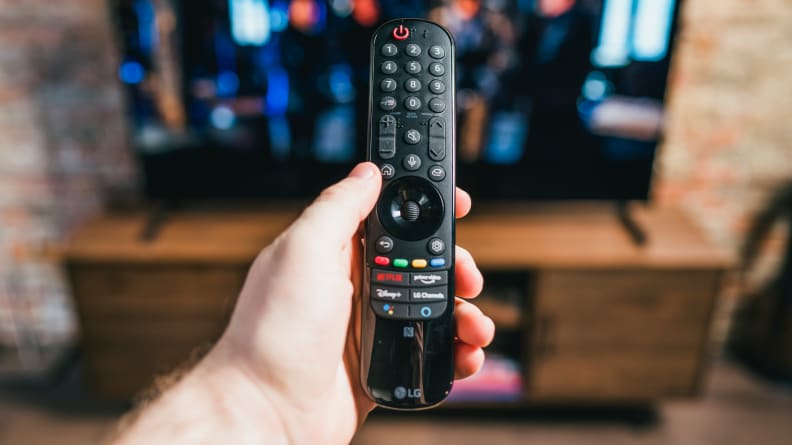
We thoroughly test every TV we review in a light-controlled lab environment, but we like to photograph 'em with the lights on.
Before testing a TV, we give it at least 24 hours to warm up in the lab. This is an important process for most TVs, but especially for new OLED panels, where a cell repair cycle between power states ensures they stabilize properly and exhibit the pixel state you’re most likely to see during use.
Testing involves taking measurements in a light-controlled lab environment using a suite of hardware (such as a Konica Minolta CS-200 light meter) and software (CalMan Ultimate) to measure the TV’s performance in a given picture mode. In this case, we tested the LG G1 in ISF Expert (Bright Room), Vivid, and Filmmaker Mode to get the best idea of its range where contrast and color production are concerned. HDR measurements are from the HDR Cinema picture setting. Here are the key takeaways from the testing process:
- HDR checkerboard contrast (reference black level/brightness): 0.001/234.4 nits
- SDR checkerboard contrast (reference black level/brightness): 0.001/155 nits
- HDR peak brightness (sustained): 736.7 nits
- HDR (DCI-P3) color gamut coverage: 99.2%
- SDR (rec.709) color gamut coverage: 100%
- Input lag (Game Optimizer on): 10 ms
Connectivity
Meant to live on a wall exclusively (though you can purchase a “Gallery stand” separately if you choose), the 2021 Gallery OLED is nevertheless outfitted with the kind of connectivity options to make it the grande dame centerpiece of your living room.
In a cutout on the back/side of the panel you’ll find a range of ports, including:
- 4 x HDMI 2.1
- 3 x USB 2.0
- RF connection (cable/antenna)
- Ethernet (LAN) input
- Digital audio output (optical)
- Headphone (3.5mm) output
According to LG, all of the G1’s HDMI inputs are HDMI 2.1/HDCP 2.2 ready, and HDMI 2 serves as the Audio Return Channel (HDMI eARC in this case).
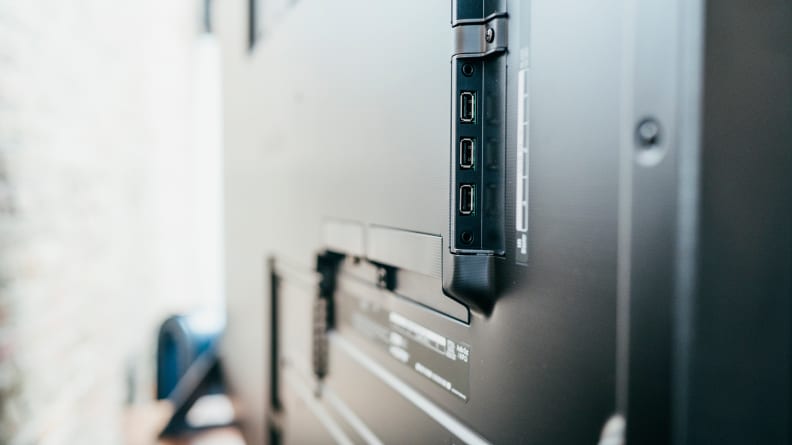
All four of the LG G1's HDMI inputs feature HDMI 2.1 compatibility, so it's set and ready to be the centerpiece of your home theater.
What we like
Stellar core picture quality
For several years, our #1 ranked TVs have been OLED models, and it’s well-established by now that OLED TVs—while expensive—justify their price tags via picture quality that LED/LCD TVs struggle to imitate.
The G1 OLED series isn’t the fanciest OLED LG has ever made—that honor is held by the “ZX” series from 2020, which offers 8K resolution at a massive price tag—but it’s the top-tier OLED flagship for 2021. We’ve traditionally recommended the “C” line of OLEDs because the “C” and “G” lines have traditionally looked almost identical from a picture quality standpoint and the “C” was the more affordable of the two.
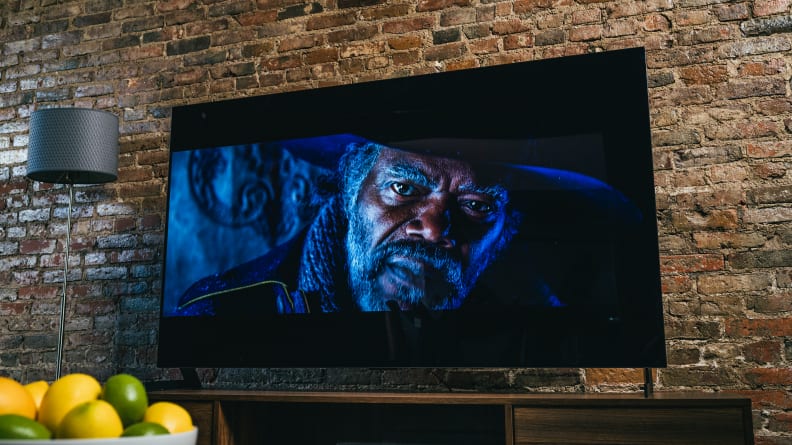
The G1's "OLED evo" panel features new diode material and better overall composition, adding higher luminance in sub-pixels to increase picture expression.
Or at least, that's how it usually goes. LG has manufactured all of the G1 series OLED TVs with a new panel type called OLED evo which is allegedly different enough from the panels you’ll find in the C1 or A1 OLEDs that it was a key focus of the company’s CES announcements back in January, 2021.
Elements like “true” black levels, 100% color saturation in SDR and 99% color saturation in HDR, and an improved Game Optimizer mode are just some of the ways the G1 justifies its price tag from a performance standpoint. To put it simply, the only time the G1 OLED doesn’t look or function at its best is in a very bright viewing environment.
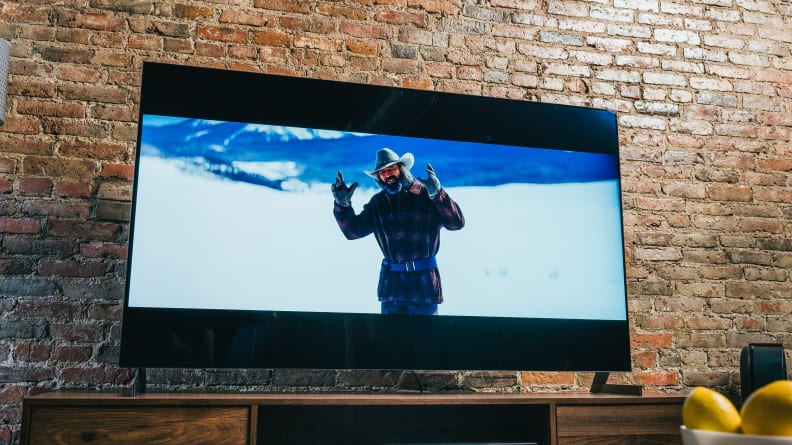
The G1's core luminance results aren't a huge leap forward compared to LG's 2020 OLEDs, but its sustained peaks and color emphasis have definitely been improved.
One area that’s clearly received marginal but still laudable improvement is in color saturation. LG claims one benefit of the evo panel is better “composition,” which seems to have a lot to do with some very nerdy TV tech. The actual OLED material itself is new (at least for the red and blue subpixels), while green has been tweaked to be more of a pure green, less a yellowish-green, an issue that was very noticeable on some of LG’s OLEDs a few years back.
Overall, the shift makes for purer, less diluted or polluted primary colors, which in turn extends to picture elements like secondary colors, skin tones, and grayscale expression. The end result seems to be richer, more accurate colors, which in turn make for an even better overall picture quality. In short: whatever you’re watching (or playing) does look just a little bit better across the board
Naturally, you’re also still getting perfect black levels here. However, while we noticed better color saturation and accuracy, the G1’s overall brightness improvements were a bit harder to outright quantify during testing—but more on that later.
Function meets artistic form
Top-notch picture quality is the main reason OLED TVs are so expensive, but that’s certainly not all you’re getting, especially with LG’s G1 OLED. While all OLED TVs stand out from the din of LED/LCD models thanks to their hyper-thin profiles and often highly embellished (or at least highly “creative”) tabletop stands.
The G1 Gallery OLED is a step even beyond that. While we tested and photographed the G1 using an optional stand, the 2021 G1 (like the GX OLED that came before it) doesn’t actually include a stand when you purchase it at retail—something interested buyers should keep in mind. They’re called Gallery models because they’re designed primarily for hanging on the wall like a work of art.
While I have no doubt that the G1 looks awesome on the wall, our office/testing lab isn’t outfitted for wall-mounting at this time, so we had to order the optional tabletop stand accessory. I’m happy to report that the G1 looks just as good on the stand as it does on the wall. Its angular, industrial feet don’t detract from its hyper-thin profile or smooth, brushed appearance of its chassis.
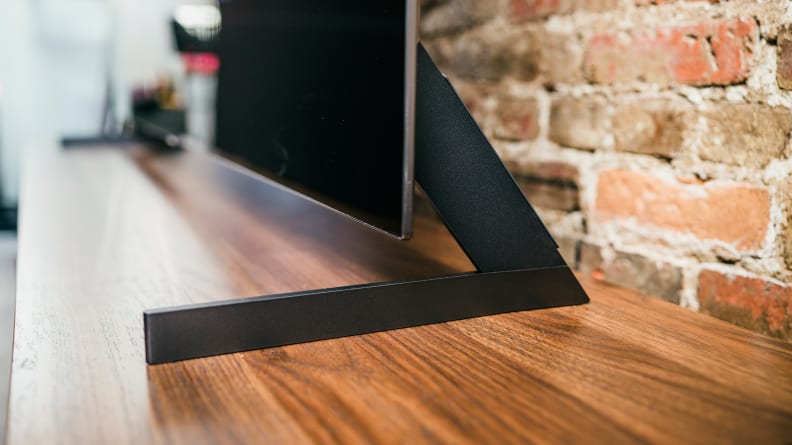
While this "Gallery" OLED is meant to hang on a wall, we think it looks pretty good on its tabletop stand, too. Just note that you'll have to purchase the stand separately.
The Magic Remote has gotten a subtle redesign, too, offering shortcut buttons for Netflix, Prime Video, Disney+, and LG Channels. However, the coolest addition to the remote is LG’s new Magic Tap function, which uses NFC (not to be confused with NFT, this means Near Field Communication) to communicate between a mobile device and the remote control.
Tapping content from your phone to your TV via NFC isn't new. But LG is one of the first manufacturers to slap the NFC tag right into the remote control itself. During a briefing, LG’s Tim Alessi mentioned how he didn’t think anyone wanted to stand up, walk over, and tap their phone on their TV whenever they wanted to cast when the remote is right there, and I’m inclined to agree. With Magic Tap, you just tap your (casting enabled) phone to the remote and it will do its best to cast that content to the G1, for one more way to easily share content.
What’s more, it works in reverse: you can have a “mini TV in the palm of your hand,” according to LG, localizing what you’re watching to your phone (and bringing the audio with it).
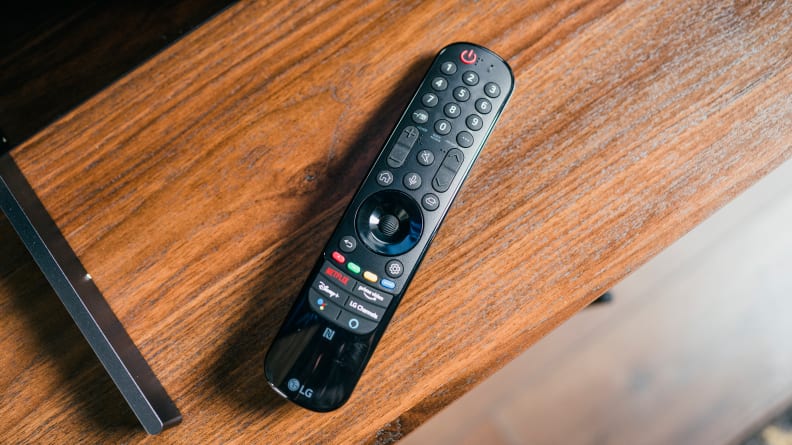
The slightly improved Magic Remote now features a built-in NFC tag, allowing you to cast easily from your phone to the TV (or vice versa).
Finally, no hardware assessment would be complete without a brief word about ports. The best thing about the G1’s input selection is that you’re getting HDMI 2.1 ports across the board: all four inputs are spec’d for the latest standard, making the G1 an especially good candidate as the centerpiece for future-facing home theaters.
webOS 6.0 embraces the streaming revolution
You’d better bet this high-end, “evolved” OLED is also a smart TV. In fact, it comes bearing the sixth generation of the webOS smart platform, which comes with a much stronger emphasis on streaming.
Moving away from traditional cable to embrace streaming isn’t anything new, but previously, webOS was much less “in your face.” The New Home screen is the biggest change year-over-year: whereas older versions of webOS populated the bottom fifth of the screen with clickable buttons, the 2021 iteration populates the entire screen with apps, suggested content, and so on.
LG’s engineers told me they thought this more-unified UI made webOS easier to use, and it’s true. While webOS has always been well-tailored to function with the “cursor-on-screen” design of the Magic Remote (which casts a pink cursor onto the screen using infrared technology, much like a Nintendo Wii remote), user feedback has often hinged on the disparate feel of sectional design from one sub-menu to the next.
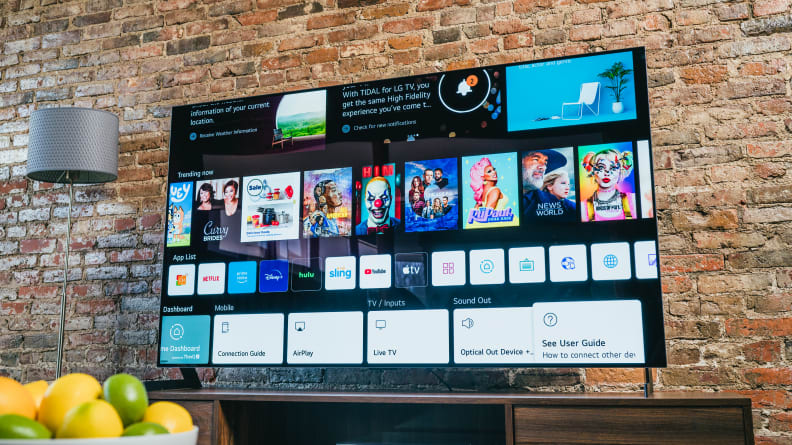
The newest webOS smart platform (webOS 6.0) now occupies the entire screen, and puts more emphasis on streaming.
This year, webOS 6.0 truly does feel more unified—or at least it has a more unified look across its various functions. LG improved upon some features, including a new Sports Alert service that helps sports fans find which games are playing and which services might offer them, and an improved version of Magic Explorer.
Magic Explorer does something similar to Amazon Prime Video’s “X-ray” feature, allowing you to pause content and quickly check things like who the actors/actresses are, what song is currently playing, and even where you can buy that stylish jacket the heroine is wearing. It’s a cool idea, but I haven't yet had a chance to test it across tons of different content.
All in all, much like the core picture quality/panel composition of the G1, this version of webOS—backed by the a9 4th-gen processor—is not hugely different from 2020, but it does shore things up nicely. It’s a snappy, intuitive experience, but, like most TV smart platforms, it’s not a selling point as much as icing on the cake.
G for Gallery? How about Gaming
Like most brand-name TV makers, LG is aware that enthusiastic gamers are a big audience for high-end, cutting-edge TVs, and the G1 comes well-packed with gaming-centric features. In fact, LG has pioneered a whole software suite/package called “Game Optimizer,” meant to take the headache out of fiddling with software menus and advanced features when switching between TV/movie watching and playing games.
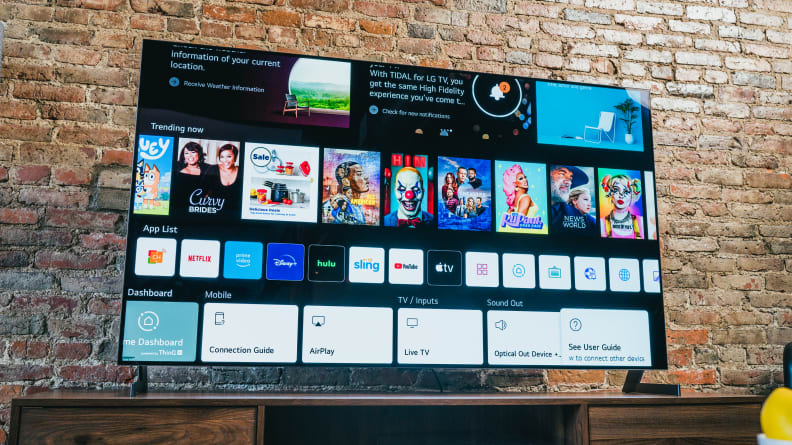
LG's new "Game Optimizer" menu handles a ton of gaming-centric settings—reducing input lag, toggling FreeSync or G-Sync, and so on—all in one place.
Game Optimizer is toggled on or off in the menu, where you can pick from game presets like “FPS,” “RTS,” or “RPG”—a function that’s been pretty standard on good gaming monitors for several years, but is only just starting to show up on TVs. Naturally, you’ll also be able to adjust all of the TV's motion settings here. The G1 still delivers a suite of MEMC (motion estimation/motion compensation) settings related to blur and judder, but you’ll also have the option to lower its blue light output (another standard gaming setting) and enable FreeSync or G-Sync, both of which help to reduce screen tearing by synchronizing the TV’s refresh rate to the source device’s processing.
Naturally, we took a few input lag measurements using the standard Leo Bodnar tester. Measurements were quite good for such a processing-prone TV: without Game Optimizer you’re getting around 80 ms of input lag, which isn’t great, but with Game Optimizer on that number drops to around 10 ms, which is excellent.
As you might have surmised already, the G1 supports VRR (Variable Refresh Rate) and ALLM (Auto Low Latency Mode) natively via the Game Optimizer settings. LG also addressed a common OLED gaming pain point by folding in a “Fine Tune Dark Areas” setting, which allows users to adjust how aggressively the TV exits black into “above black” shadow areas, which can sometimes be elevated or crushed depending on the game. This later setting is also rolling out to some older OLEDs, too, according to LG.
All in all, the G1 is kitted out to handle current-gen gaming about as well as most premium gaming monitors. Whether you’re playing games or watching sports, the G1 is going to handle everything smoothly.
A bit about HDR brightness
One area in which we really expected huge improvements was brightness, or luminance production. At a glance, the G1 has almost the exact same brightness numbers as the 2020 CX series. However, there’s a bit more going on here.
The way HDR brightness is handled requires TVs to assess the incoming HDR metadata and produce brightness numbers both in reference to other brightness numbers and in reference to the duration that the brightness will need to be displayed. This can lead to static test patterns not always reflecting the full capability of a high-end HDR TV.
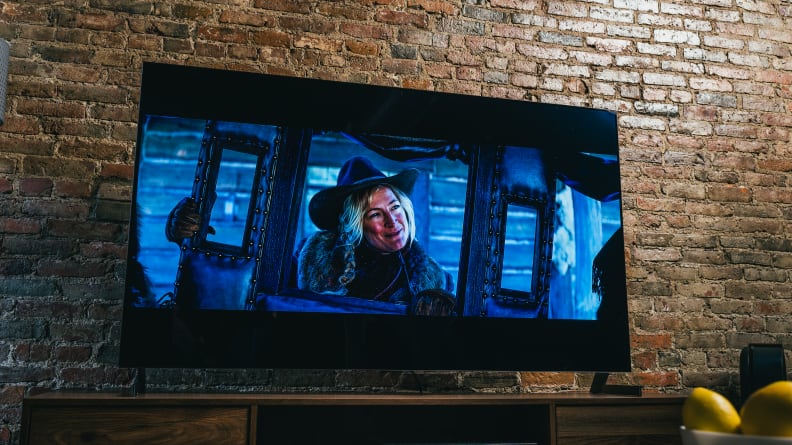
Like all HDR TVs, the G1's luminance during scenes peaks and then sustains at a lower brightness level across scenes. This ability has been improved compared to last year's LG OLEDs.
The G1’s ability to hit around 400 nits of HDR brightness on specular highlights and almost 800 nits during particular patterns puts it in line with previous OLEDs, but its ability to sustain high brightnesses (and to occasionally excurse above that 700-800 mark) is the real secret of the evo panel.
Unfortunately, testing for this kind of thing is not a science. But the TV’s expanded color saturation and improved primary color peaks (in luminance) suggest an ability to produce higher brightnesses than what we’ve managed to measure.
It’s worth noting that by “improved brightness,” LG may mean brightness/luminance of individual colors as much as it does the overall white luminance. With new OLED material in use in this panel, we measured higher luminances on the sub-pixel level (meaning primary colors like red, green, and blue are brighter) while the same white balance (D65, the TV standard) has been maintained. All in all, it’s proof that there’s more to the evo panel than marketing bluster.
I can let you do that, Dave
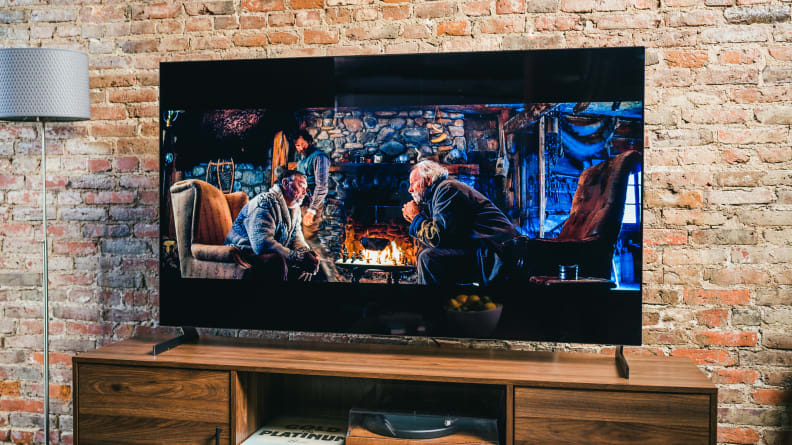
LG's new a9 Gen 4 processor uses AI learning to optimize the video and audio of scenes, tending to adjust between night scenes, landscapes, and the complex contrast of cityscapes.
Finally, the 2021 G1 series is stuffed with cool AI features worth mentioning. The a9 Gen 4 AI processor enables a whole range of picture processing goodies like upscaling, object enhancement, auto genre selection, and a new feature called “scene detection” that, according to LG, adjusts the picture processing between scenes in a movie or TV show depending on what’s on-screen.
These scenes include “scenery mode,” “building mode,” and “nighttime mode,” adjusting the composition of the scene depending on what the TV “thinks” it’s displaying. There’s also AI functionality happening in the presentation of sound: the previous virtual upmix of 5.1-channel sound has now been expanded to 5.1.2-channel sound, adding virtual height channels.
We haven’t fully tried out all of these AI features, but we can at least confirm that they seem to work in the background (as they should) to optimize the video and audio quality while watching different kinds of content.
What we don’t like
You’re buying everything and the kitchen sink, too
Outside of the bananas 8K-resolution equipped ZX OLED, the “G” (Gallery) models every year present LG’s top OLED TV. They also offer the highest margins, considering these TVs are expensive to produce and maintain. And every year, the fancy Gallery OLEDs are stuffed with every conceivable aesthetic and technical upgrade in order to justify their huge price tags.
There’s nothing wrong with this, but if you just want OLED picture quality without paying for things like improved sub-pixel luminance or “flush” wall-mounting, you could pick up the C1, which is notably less expensive at MSRP (though sale prices may vary).
While it’s a bit odd to call out price as a “con” in a review where almost all of the “pros” consist of pouring tons of expensive research and tech into a product, that’s just the case here. Most people will never be able to afford the G1 at full price, as excellent as it may be from corner to corner.
No DTS support means Blu-ray options are limited
Following our initial review, we discovered LG has dropped support for DTS audio in its TVs made after 2020. This means that, if you have a large Blu-ray collection with DTS audio tracks, you'll need to plug your player into an A/V receiver or supported soundbar to decode the full audio track, rather than your TV directly. Since we expect most folks with this kind of setup to have a properly dedicated audio device anyway, we don't think this will be much of an issue for most prospective buyers (LG obviously didn't). But it's something to note if Blu-ray is your preferred video experience.
Should you buy it?
Yes—if you’ve got the money and want all the bells and whistles
The G1 has some competition in the form of Sony’s excellent A90J OLED, but few TVs can compete with its picture quality and features. LG has confirmed that it doesn’t think any of the company's QNED TVs will stand up to its OLEDs, and the G1 is the fanciest OLED that LG produced in 2021. So if you’ve got the scratch and want a very high-end OLED, your options are pretty much down to this one and the Sony A90J.
If you want to take a tiny step down, our favorite TV of 2021, the LG C1, has never been cheaper than it is right now. From a performance standpoint, it's almost as good as the G1, and you'll find sale prices are common right now for all five of its size options.
Cost aside, the G1 OLED is a feast of abilities and upgrades. The core panel has been highly tuned, covering almost 100% of the HDR color space and integrated with an excellent processor to handle any kind of movie, TV, gaming, or sports content with picture quality as good as some of the best TVs ever produced. As far as this current generation of mainstream TV specs go (4K resolution, 10-bit color space), the G1 OLEDs may be some of the very best that we get before 8K content and 12-bit color spaces go totally mainstream.
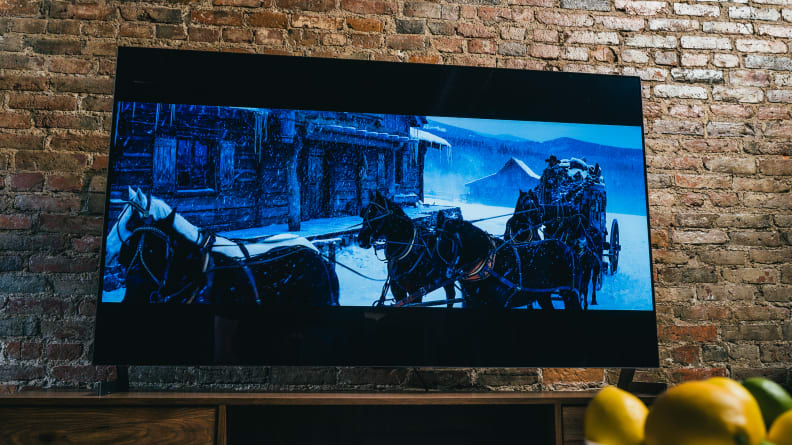
The LG G1 OLED is bound to be one of the best TVs of 2021, but it doesn't come cheap.
That said, they aren’t flawless. Modern TVs tend to be a work in progress, receiving firmware updates in response to consumer pain points and unforeseen incompatibilities with third-party hardware. Yet from a possibilities standpoint, the G1 is ready for just about anything you throw at it. If you’re trying to decide between the G1 series and the A90J OLED, my only tip here is to remind you that LG produces the panels for Sony’s OLED TVs, so in many ways, their core performances should be extremely similar. Preference may come down to out-of-the-box settings, design, or even smart software—would you rather have webOS or Google TV?
All that said, the LG G1 OLED series is certainly a victory, if a subtle one. We weren’t expecting the next color space or 1,000+ nits of sustained brightness, but anyone who was may be disappointed with the evolution here. However, if you haven’t been tracking OLED progress every year and have just been thinking about buying one, the kitted-out G1 may be your best bet. Almost all of the old OLED kinks have been worked out, and what we’ve got now is a highly tuned, much-loved machine that fires on all cylinders. If price is no object, the G1 spurs no objections.
Meet the testers
Lee was Reviewed's point person for most television and home theater products from 2012 until early 2022. Lee received Level II certification in TV calibration from the Imaging Science Foundation in 2013. As Editor of the Home Theater vertical, Lee oversaw reviews of TVs, monitors, soundbars, and Bluetooth speakers. He also reviewed headphones, and has a background in music performance.
Julia is the Senior Scientist at Reviewed, which means that she oversees (and continually updates) the testing of products in Reviewed's core categories such as televisions, washing machines, refrigerators, and more. She also determines the testing methods and standards for Reviewed's "The Best Right Now" articles.
Checking our work.
Our team is here to help you buy the best stuff and love what you own. Our writers, editors, and experts obsess over the products we cover to make sure you're confident and satisfied. Have a different opinion about something we recommend? Email us and we'll compare notes.
Shoot us an email
